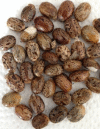Castor Oil: Properties, Uses, and Optimization of Processing Parameters in Commercial Production
- PMID: 27656091
- PMCID: PMC5015816
- DOI: 10.4137/LPI.S40233
Castor Oil: Properties, Uses, and Optimization of Processing Parameters in Commercial Production
Abstract
Castor oil, produced from castor beans, has long been considered to be of important commercial value primarily for the manufacturing of soaps, lubricants, and coatings, among others. Global castor oil production is concentrated primarily in a small geographic region of Gujarat in Western India. This region is favorable due to its labor-intensive cultivation method and subtropical climate conditions. Entrepreneurs and castor processors in the United States and South America also cultivate castor beans but are faced with the challenge of achieving high castor oil production efficiency, as well as obtaining the desired oil quality. In this manuscript, we provide a detailed analysis of novel processing methods involved in castor oil production. We discuss novel processing methods by explaining specific processing parameters involved in castor oil production.
Keywords: castor beans; castor oil; crude castor oil refining; nonedible oil; ricinoleic acid.
Figures







References
-
- Ogunniyi DS. Castor oil: a vital industrial raw material. Bioresour Technol. 2006;97(9):1086–1091. - PubMed
-
- Mutlu H, Meier MAR. Castor oil as a renewable resource for the chemical industry. Eur J Lipid Sci Technol. 2010;112(1):10–30.
-
- Thomas A. Ullmann’s Encyclopedia of Industrial Chemistry. Wiley-VCH Verlag GmbH & Co. KGaA; 2000. Fats and fatty oils.
-
- Hong D-Y, Blackmore S. Plants of China: A Companion to the Flora of China. Cambridge University Press; 2015.
-
- McKeon T, Hayes D, Hildebrand D, Weselake R. Industrial Oil Crops. Elsevier; 2016.
Publication types
LinkOut - more resources
Full Text Sources
Other Literature Sources

